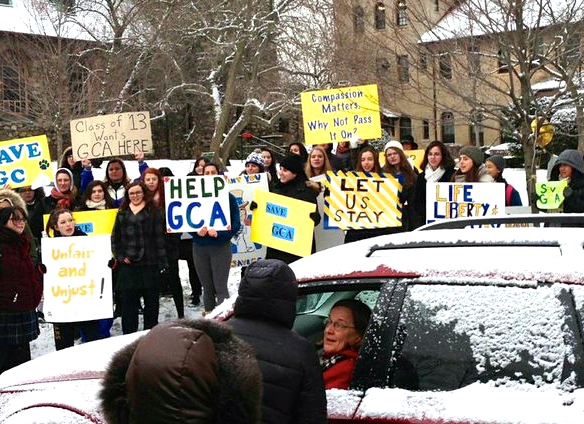Tensions Fray as Two New Castle Coyote Plans are Presented

The New Castle Town Board will weigh recommendations submitted by two committees it appointed last year that were asked to devise plans to keep residents and their pets safe from coyotes.
Last week, the Coyote Awareness and Safety Advisory Committee presented its proposal during the Feb. 10 meeting, which outlined a detailed co-existence plan to educate residents on how to greatly reduce the chances of interaction between coyotes and humans and their pets.
The second committee, the Coyote Management Task Force, which submitted a written plan and aired a 34-minute taped presentation on the town’s website two days later, supports a community education program as well but also advocates for trapping, and as a last resort, humanely destroying a coyote that has exhibited unusually aggressive behavior.
The task force decided against presenting their report in person after the Connecticut-based animal rights group, Friends of Animals, posted a release on its website and on social media platforms early last week characterizing the task force as an “anti-wildlife group.”
In a statement read by Town Administrator Jill Simon Shapiro, the task force said it was subjected to unnecessary and frightening threats.
“Unfortunately, before we even had the chance to present our findings and recommendations, our plan was characterized as a ‘coyote jihad,’ ‘a Draconian killing plan’ (and) ‘misguided and hateful,’ all before our plan had ever been presented,” the statement read in part.
An increase in coyote sightings and documented attacks on pets in recent years prompted town officials last year to appoint a committee to study the issue and propose recommendations. However, members were unable to work with each other, said Supervisor Robert Greenstein. As a result, the members were split into two groups.
Greenstein and Councilman Adam Brodsky said that the town board would likely hold a work session in March or April to discuss each proposal and whether to incorporate the recommendations into an official policy.
In their presentation, Victoria Alzapiedi, chair of the Coyote Awareness and Safety Advisory Committee, and committee member Michael Zuch, cited New Castle Police Department statistics showing that coyote attacks are uncommon. The statistics showed that one pet was killed each year by a coyote from 2009 to 2011. There have been five coyote attacks on pets in town since then, according to police records.
Zuch said that the coyote population does not view residents’ pets as our family members but as potential prey or competitors. However, if residents use common-sense strategies such as keeping their dogs on leashes during walks, feeding pets inside, properly storing trash and compost material and learning how to “haze” or scare away coyotes, virtually all threatening interactions can be eliminated.
“The good news is that almost all coyote-pet conflicts are avoidable, preventable, if pet owners make some small changes in their routines,” Zuch said.
The committee said that lethal control should be avoided unless there’s an unprovoked attack on a person, a pet is attacked while under human control or if a coyote exhibiting dangerous behavior is diseased. It has virtually no impact on local populations.
Alzapiedi said she was “very disappointed” that the task force recommended removal, which she called “extreme and unnecessary.”
“Our committee has learned that there are many, many steps that our community and our residents can take to correct and modify less desirable behavior exhibited by a coyote,” she said.
Meanwhile, the task force listed many similar communitywide education strategies regarding trash disposal, elimination of food sources and walking dogs on leashes. It also called for mapping and using social media and Nixle alerts to inform the public of coyote hot spots so residents avoid those areas.
Areas of Gedney Park, for example, with a high concentration of children has been a noted den site, particularly in pup rearing season.
Trapping and removing coyotes who are habituated and are overly aggressive to pets and people should be kept as an option of last resort.
“Resident safety is the priority in managing wildlife-human conflicts,” said task force member Ann Styles Brochstein in the taped presentation. “The plan seeks to achieve a balance between the importance of resident safety and the benefits of maintaining natural wildlife populations.”
They also asked the town for a full-time animal control officer and to establish a decision matrix for when trapping and removal is warranted.
Task force member Eileen Gallagher said that the official police statistics don’t tell the whole story. On the task force’s Facebook page, Gallagher said there have been at least 10 attacks on pets reported from May 2013 through December 2014.
Teaching proper hazing techniques is also essential; however, Brochstein said hazing can have diminishing success because some of the animals eventually realize they will suffer no harm.
“It is the opinion of the Coyote Management Task Force that co-existence with people is possible,” Brochstein said. “It’s also the opinion of the task force that the coyote problem in New Castle has reached potentially dangerous levels. Through a combination of approaches, utilizing what has worked for other communities and identifying what actions our town is comfortable with, we believe that with a multifaceted plan the town will be able to deal effectively with coyotes to protect residents and pets in New Castle.”

Martin has more than 30 years experience covering local news in Westchester and Putnam counties, including a frequent focus on zoning and planning issues. He has been editor-in-chief of The Examiner since its inception in 2007. Read more from Martin’s editor-author bio here. Read Martin’s archived work here: https://www.theexaminernews.com/author/martin-wilbur2007/

